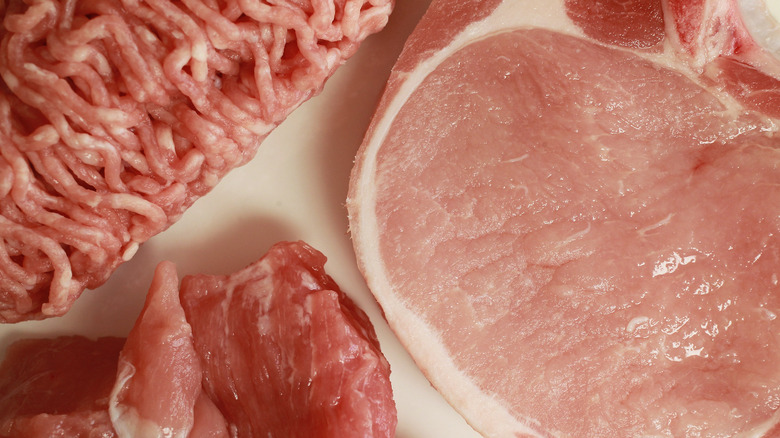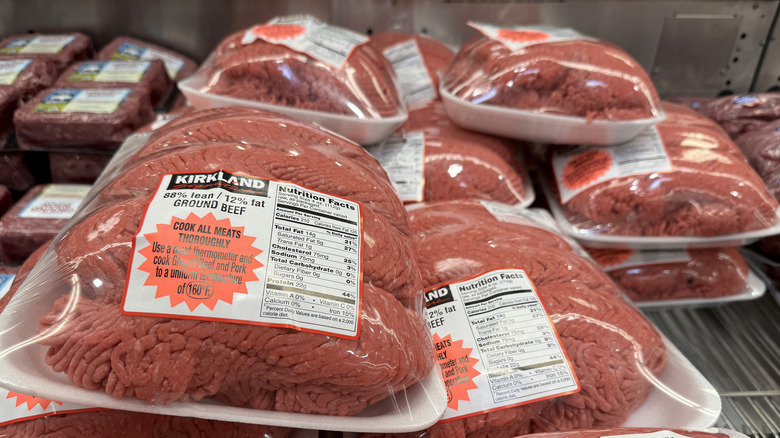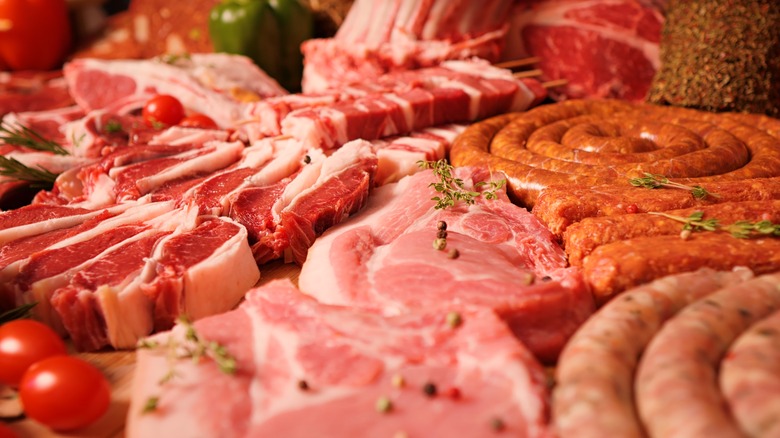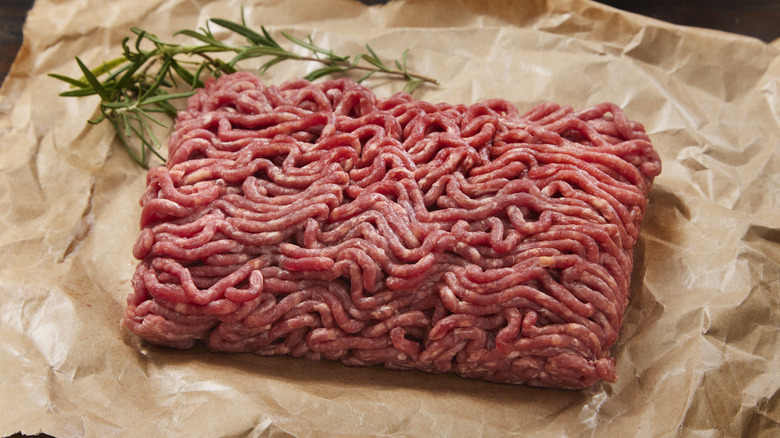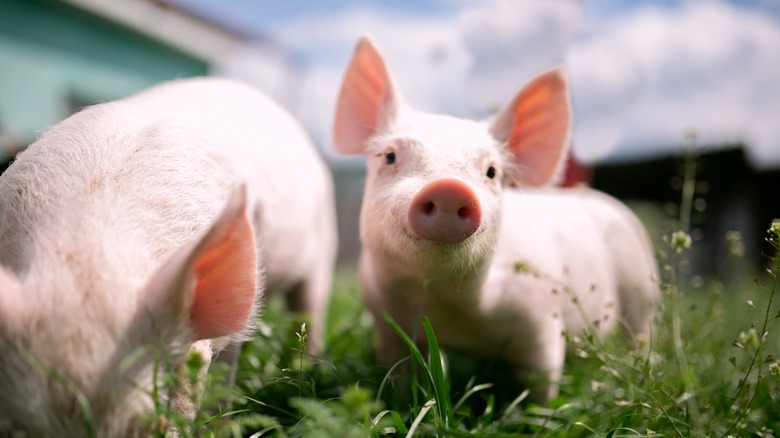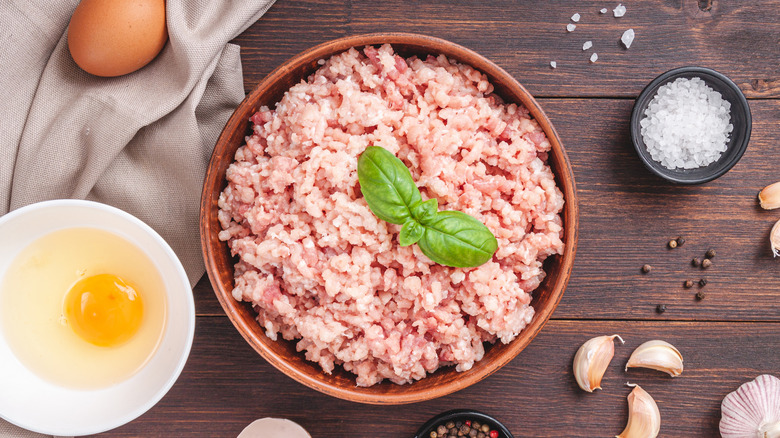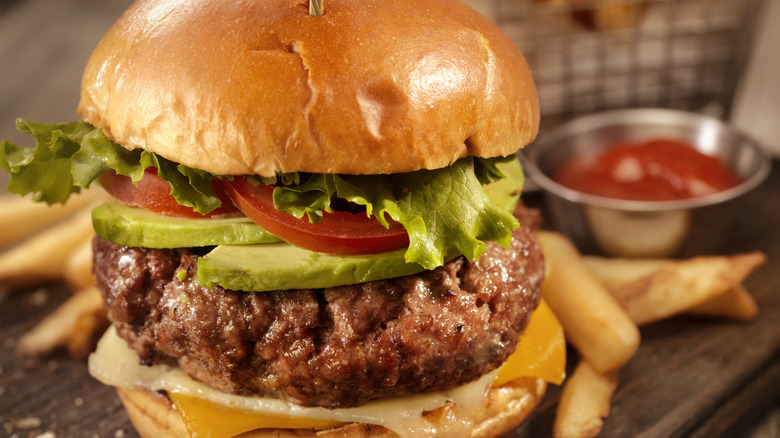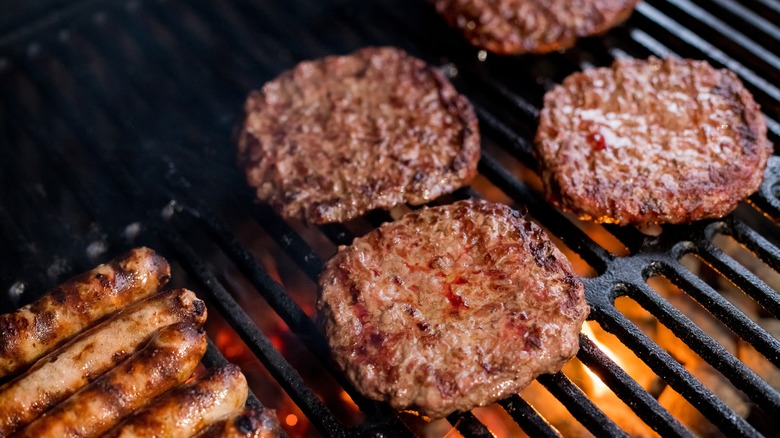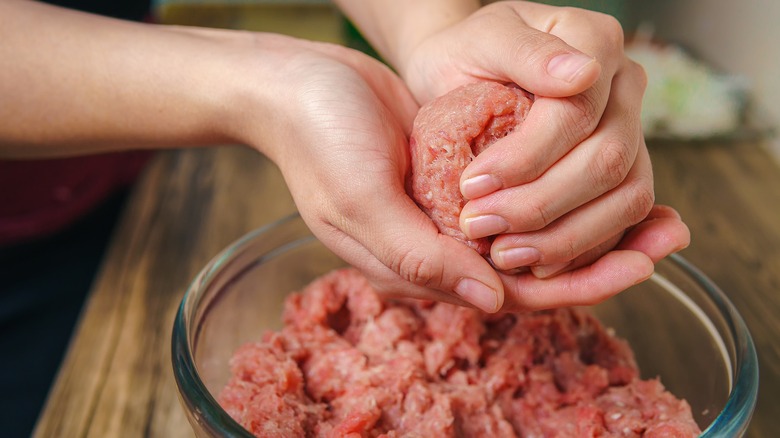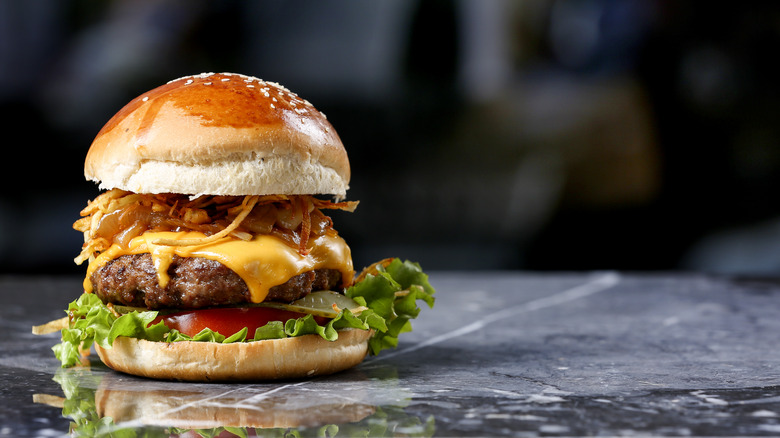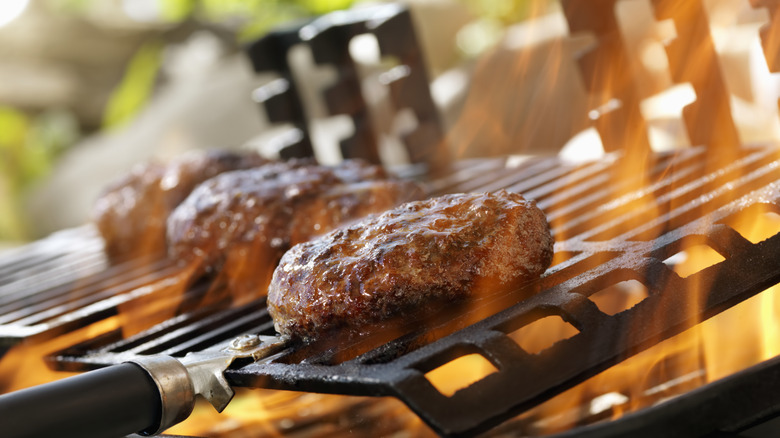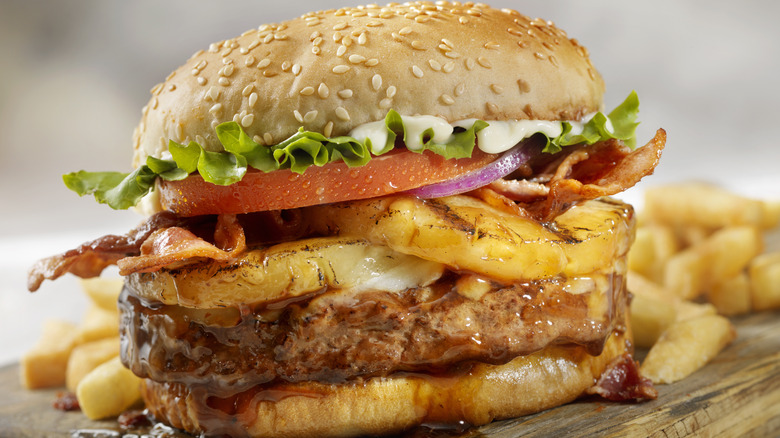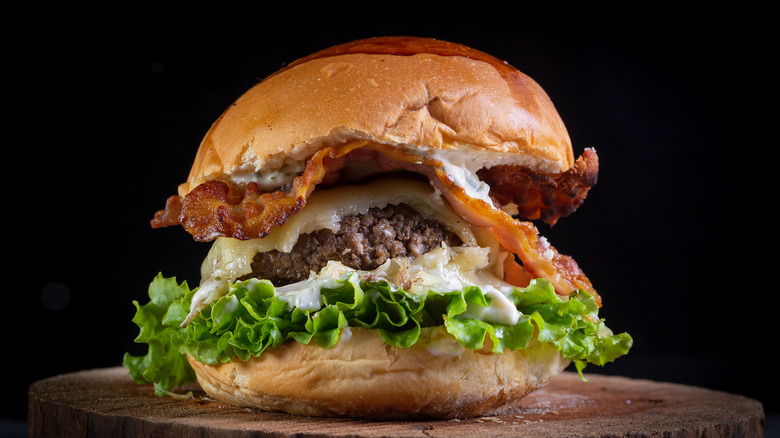Pork Burgers Vs Beef Burgers: Everything You Need To Know
When it comes to creating juicy, flavorful burgers, many people fall in one of two camps: beef or pork. Both are versatile meats that can be ground or minced to create hamburger patties. Provided they're prepared and cooked properly, both can result in tasty burgers. But does one create a better burger than the other? And how do they differ in terms of flavor, texture, and cooking techniques?
Technically, the first hamburgers were made with beef. Hamburgers get their name from the German city of Hamburg, which is often cited as the first place where minced beef was formed into patties and fried or broiled. Originally called Hamburg steaks, these patties became hamburgers when someone had the brilliant idea to pack them into a bun. Over time, hamburgers have evolved to include other meats like pork, chicken, and turkey.
If you're debating whether to use beef or pork in your burger mix, you should know that there are some differences between the proteins that can affect how your burgers turn out. Armed with these helpful facts and tips, you'll be able to make the perfect burger whether you're using pork or beef — or both.
Pork is less expensive
With the cost of groceries on the rise, you've probably noticed that pork is one of the cheaper meats you can buy. According to a USDA National Retail Report, the average retail price for a pound of ground pork in the United States is $3.71. A pound of Italian sausage averages $4.26 a pound at retail supermarkets. By comparison, the USDA's report for beef reveals that the national average price for a pound of ground beef chuck is $5.02. That's not a huge difference, but it can add up.
Ground pork is typically made from pork shoulder or pork butt, both of which can be very wallet-friendly. There are a few reasons why pork shoulder and butt are so inexpensive. First, it costs less to raise pigs because the food they eat is cheaper. Pigs can eat a wide variety of foods, while cows need to eat huge amounts of grains, corn, and grasses like hay. Plus, pigs grow faster than cattle, so they don't need to be nurtured for as long. In addition, an article by CNBC reports that beef production decreased significantly during COVID-19, and that has caused the price of beef to skyrocket. While pork prices have also risen since the pandemic, they haven't gone up nearly as much as beef.
Ground beef may be easier to find
It's no secret that the U.S. has a love affair with beef. According to the USDA, Americans consume an average of 56 pounds of beef per person per year. Iowa State University reports that nearly half the total retail beef consumption in the United States is ground beef. That makes sense considering that tender cuts of steak are typically more expensive than ground beef. Minced or ground beef is also relatively easy to cook and can be used in a wide variety of ground beef recipes including meatloaf, meatballs, chili, bolognese sauce, and burgers.
Because ground beef is in high demand, it's often readily available at most supermarkets in the States, whereas ground pork may be harder to find. If your go-to grocery store doesn't have ground pork for sale, you have a few options. One is to head to an Asian supermarket if you have one nearby. Ground pork is a common ingredient in many Asian recipes, so specialty Asian stores might stock the meat. Another option is to ask your butcher to grind some pork for you. If you have a meat grinder at home, you can also grind your own pork for burgers.
Both are red meats
One of the common misconceptions about pork is that it's a white meat. However, pork is actually classified as red meat. The reason why pork is often called "the other white meat" is thanks to a National Pork Board promotional campaign that dates back to 1987. The campaign aimed to showcase pork as a healthy, nutritious meat on par with chicken. The NPB used the tagline for decades, only retiring it in 2011 and replacing it with "Pork, Be Inspired." Despite that, the white meat slogan is still highly recognizable and one that many people take as fact.
The final word comes down to the USDA, which states that pork is indeed a red meat. This is because of a protein called myoglobin that stores oxygen in the muscles. According to AskUSDA, "The amount of myoglobin in animal muscles determines the color of meat. Pork is classified a red meat because it contains more myoglobin than chicken or fish." This means that pork falls in the same category as other livestock such as beef, lamb, and veal. It should come as no surprise then that pork also works well in burgers.
Beef has more protein than pork
Nutrition-wise, ground beef and ground pork differ in a few key ways. One of the main differences is the protein content. According to the USDA, a 100-gram serving of ground beef contains 27.7 grams of protein. USDA data shows that the same 100-gram serving size of ground pork contains 16.9 grams of protein. The FDA recommends that adults consume 50 grams of protein a day, depending on your caloric needs. That means you could be getting over half the protein you need in a day just from one 100-gram beef burger.
Beyond the protein content, ground beef and pork are similar in many ways. The same USDA data reports state that 100 grams of ground beef contains 256 calories, while 100 grams of ground pork contains 263 calories. Both ground pork and beef have zero carbohydrates. The red meats are both good sources of zinc and iron, although ground beef contains slightly higher levels of both than ground pork. The bottom line is a beef burger will pack more of a protein, iron, and zinc punch than pork, but beyond that, you won't get too many extra nutritional benefits.
Pork is more environmentally-friendly than beef
Neither pork nor beef are the most eco-friendly foods on the planet. All livestock need large quantities of food, water, and land to grow into healthy animals that are fit for consumption. Large farming operations need an incredible amount of energy to maintain the animals and the crops that are required to feed them. In addition, both pigs and cows create manure that contains nitrogen and phosphorus. If not managed properly, animal waste can emit methane into the air and pollute waterways.
If environmental concerns are playing on your mind, pork may be the better choice for your burgers than beef. According to climate consulting firm SuFu, "Beef production is estimated to require approximately 20 times more land and emits 11 times more greenhouse gases compared to pork production." While cows need specialized diets of corn and grains, pigs are omnivores that can eat pretty much anything including food waste, which kills two birds with one stone. Pigs also convert food into protein more efficiently than cows. In addition, they reproduce and grow fasterthan cows, meaning they take up less resources in their lifespans.
Pork has a sweeter taste than beef
For many people, the preference for pork burgers over beef burgers or vice versa comes down to taste. Ground pork tends to have a milder, sweeter flavor than ground beef. This could be because of the diets that pigs and cows eat. Some pig farmers supplement their hog's diets with fresh fruit and vegetables, which could lead to sweeter tasting meat. A study published in the Journal of Animal Science also suggests that high-energy grains, like the ones cows on cattle farms typically eat, can lead to more intense tasting red meat.
Because of its mild flavor, ground pork often needs additional spices to amp up the flavor. For example, you may want to add some fresh herbs to bring out the brightness of the meat. Sage, thyme, and parsley work particularly well with pork. Consider combining spicy sausage and pork to create chorizo burgers with a kick of heat. You can also create your own sausage burgers with spices like oregano, paprika, and fennel seeds. Don't be afraid to experiment with different flavors that will complement or enhance the sweetness of the pork.
Ground beef is more robust
It's not just the flavor of ground beef that's stronger than ground pork. The texture of the meat is also more robust. This is both a blessing and a curse. On one hand, a good burger patty can provide a satisfying, meaty bite and it should be able to hold its own against an array of sauces and condiments. On the other hand, beef burgers can become dry and tough if they're not prepared and cooked properly. There's nothing worse than biting into a burger that has the consistency of a hockey puck.
If you're planning on making your own beef blend for burgers, the cut of beef you use matters. Some cuts like brisket and skirt steak tend to have a grainy texture that can prevent your patties from sticking together. That could lead to you making one of the biggest mistakes people make when cooking burgers — overworking the meat. Manhandled burger meat is almost guaranteed to be tough. Look for cuts that are more tender and have a good ratio of lean meat and fat like chuck steak and short ribs.
Both pork and beef should have some fat content to make the burger juicier
If you're trying to be more health-conscious, you may be tempted to choose lean beef or pork for your burgers instead of fattier products. However, lean meat won't give you the richness and moisture that the fat imparts. This is true for both pork and beef. The trick is to get just enough fat to make the burger juicy and flavorful without turning it into a greaseball. A good rule of thumb is to choose a blend of 80% lean meat and 20% fat.
When buying ground beef, check the labels on the packaging to determine the fat percentage in the meat. The maximum fat ratio allowed by law is 30% fat to 70% lean meat. Keep in mind that there is a difference between ground beef and hamburger meat. While both may contain up to 30% fat, the fat in ground beef comes from the meat trimmings. The fat in hamburger meat fat can come from other sources. Pork can be a bit trickier because it's typically not labeled with the percentage of fat to lean meat. If you want to add more fat to your ground pork, consider adding pork belly or lard.
Ground meat can become mealy or mushy if you add too much acid
You may come across burger recipes that call for tangy additions like Worcestershire sauce or red wine vinegar. Be careful with your use of acid though because it can make your burgers mushy. Acid tenderizes meat by breaking down the fibers in the protein. Acidic ingredients like citrus juices are often used to tenderize tougher cuts of meat like sirloin and flank steak. Lime or lemon juice is also the key to "cooking" the raw fish in ceviche. However, ground beef and pork are already soft, so adding acid can take them over the top and make them mealy or soggy.
That's not to say you can't use any type of acid in your burgers. A dollop of Dijon mustard or a scant splash of apple cider vinegar can add flavor and moisture to the mix. Just keep in mind that the longer the meat marinades in the acid, the more the fibers will break down. If you're planning on preparing your burgers the night before your barbecue, you may want to leave the acid out. Also, you'll want to be judicious about your use of acid. A little bit goes a long way in burger blends.
You can combine beef and pork for a tastier patty
Many chefs will tell you that for impossibly rich burgers, you need more than just beef. One of the top meats you should be adding to your burger mix is pork. The slightly sweet flavor of the pork melds beautifully with the bold meaty flavor of the beef. The soft texture of the pork can also make the burgers less dense, resulting in a better bite and mouthfeel. Pork can also add more fat to the mix, which adds another dimension of taste and texture.
There are several different ways you can incorporate pork into your burgers. You can use a mix of ground beef and ground pork for a classic burger that doesn't stray too far from the traditional. You can also take notes from burgers in Spain and add serrano ham or chorizo. For an interesting mix, consider combining lean ground beef with pork belly for a nice blend of fat and flavor. Then there is bacon, arguably the king of all pork products. Chop it up and mix it in with the burger mix or add some crispy strips on top of the burger for extra fat, crunch, and saltiness.
Both beef and pork burgers should be cooked to 160 degrees
There's a common myth that pork burgers need to be cooked all the way through, while beef burgers can be served at any temperature just like steak. That's not entirely true. According to the USDA, all ground meat should be cooked to an internal temperature of 160 degrees. This is to ensure that any bacteria or parasites on or in the meat are effectively killed off. The main concern with beef is a bacteria called E.coli, while pork may contain a parasite called Trichinella spiralis that can cause trichinosis. Both can be destroyed by thoroughly cooking the meat.
The main problem that many people have with cooking their burgers all the way through is that the burgers can be too dry. Fortunately, there are some ways around that. Grillmaster Dustin Green told Mashed that one thing people do wrong when grilling hamburgers is cooking them at too high a temperature. He said the ideal grill temperature should be between 425 and 475 degrees. Others say you should you should avoid grilling burgers altogether because it can dry out the meat. For example, celebrity chef David Chang spoke out against grilling burgers on his podcast "The David Chang Show." He recommends using a pan or griddle instead to retain the juices and flavor.
Pork burgers taste great with fruit
Few foods go better together than pork and fruit, and people have been pairing the two for centuries. One of the oldest recipes dates back to the first century A.D. and details how to make a savory pork and apple stew. The reason pork and fruit work so well together is because the sweetness of the fruit adds a brightness to the mild flavor of the pork. The acidity in the fruit can also help cut through some of the richness of the fat in the pork.
One of the most popular fruit toppings for pork burgers is pineapple. Add a few slices on your pork patty to bring a sweet, juicy element to your burger. Jamie Oliver tops his pork burger with sliced pears and blue cheese. The contrast of creamy, funky cheese and sweet, crunchy pears takes the flavor profile and texture of the burger to the next level. Andrew Zimmern adds tomatillo salsa to his burgers. Tomatillos are small green fruits that are similar to tomatoes, but slightly more tart. You could also try adding sliced apples, mango chutney, or sautéed plums to your pork burger.
Beef burgers can handle pretty much any topping
While the somewhat mellow flavor of pork burgers can be overwhelmed by stronger flavors, hearty beef burgers can handle pretty much any ingredient you throw on them. Vegetables and fruits can add layers of texture and freshness, while additional meats can add saltiness and amp up the protein. Sauces and condiments can impart moisture and enrich the flavor. And who can forget luscious, gooey cheese? Whether you like your burgers classic with lettuce, tomato, and cheese or with gourmet additions like bourbon bacon jam and basil pesto aioli, there's no end to the creative combos you can make.
Some of the most epic burger toppings we've ever seen include chocolate-dipped bacon, peanut butter, and fried ice cream. Bizarre? Definitely. Tasty? That's purely subjective. Another unusual burger topping that's gained a cult following resembles a California sushi roll. It includes crab, cucumber, wasabi, and avocado. Other interesting toppings could include lobster, poutine, and jalapeño poppers. Feel free to experiment with different toppings for your beef burgers. After all, what constitutes the best and worst burger toppings is really up to you.

